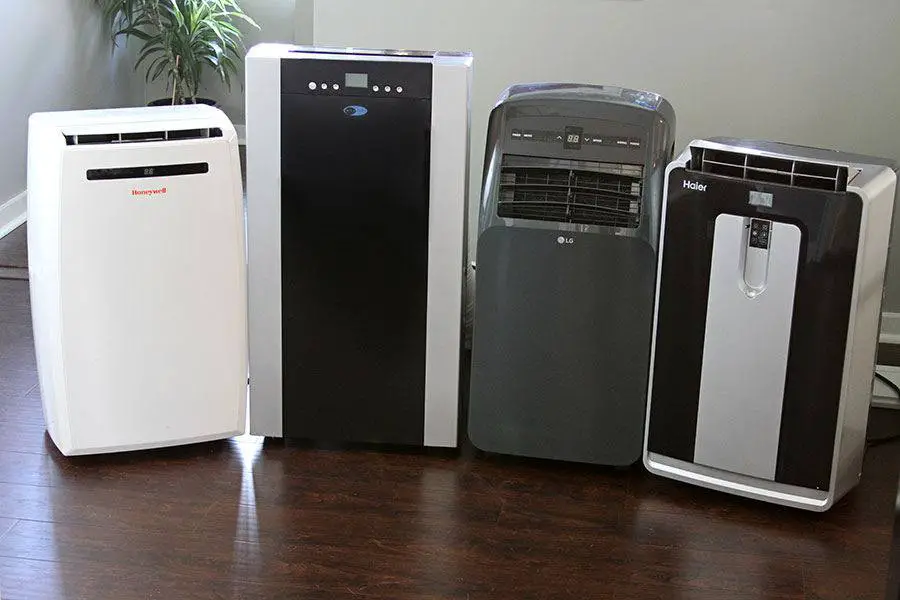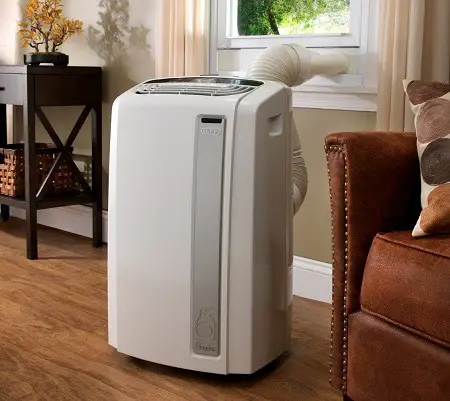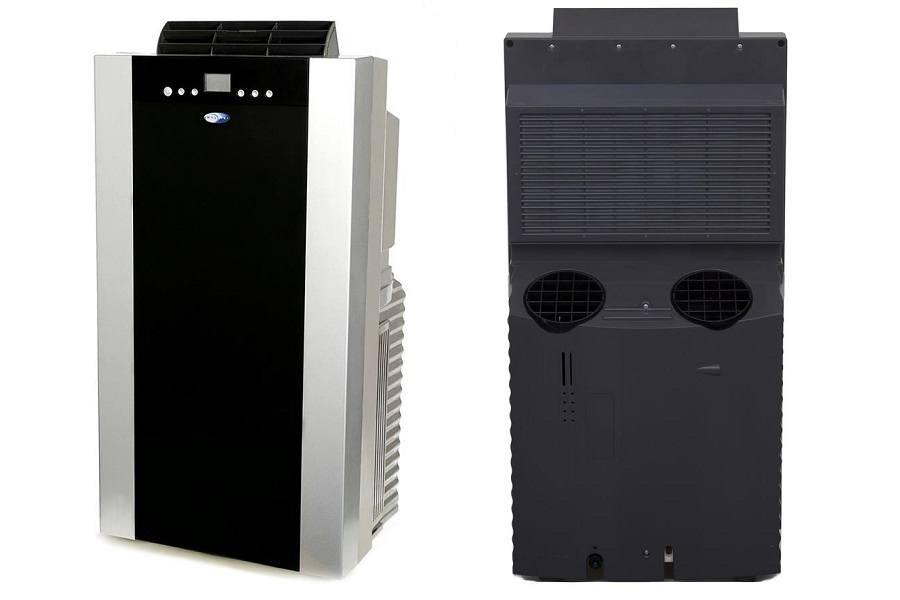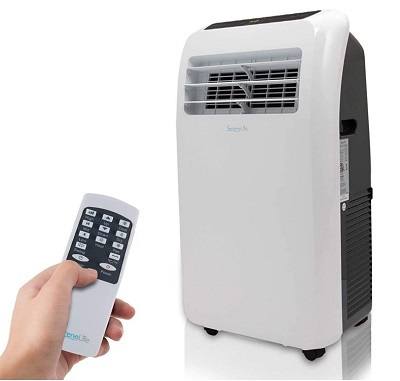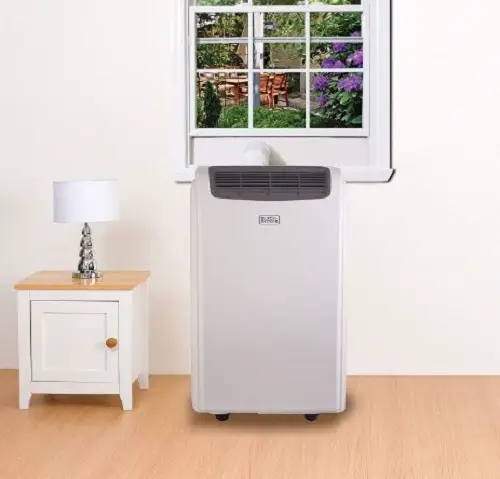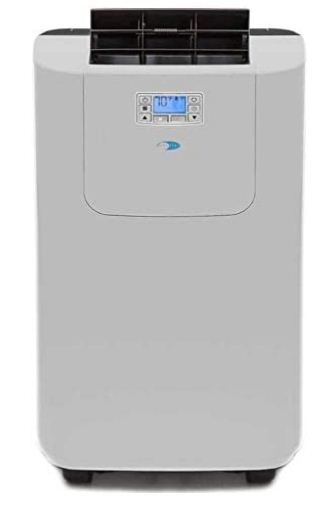Need a portable air conditioner for your home?
You've come to the right place!
If you've been shopping for a portable AC recently, then you know there are a LOT of choices available in the market - from small hand-carried units for a small home office or bedroom, to semi-permanent units meant to serve multiple rooms.
When it comes to choosing the best portable air conditioner for your room and unique needs, there are a few key factors to consider - other than brand and price.
While it may be tempting to just buy the largest air conditioner/BTU rating you can afford, or maybe buy the smallest one thinking it will save you energy, neither of these strategies is smart.
The best way to pick a portable air conditioner is to select a few units that have the right BTU rating for the size of room(s) you're trying to cool; then, consider the other practical matters including:
What’s in This Guide?
This 15-minute buying guide will tell you everything you need to know to select the best portable air conditioner for your room, home, garage or office. In it, we recommend the absolute best unit to buy for various room sizes and applications.
So, let's get to it!
Not Enough Time to Read Everything?
Enter your email below to get this Portable AC Buying Guide emailed to you as a handy .pdf eBook that you can read later on, or share with a friend.
The Four Basic Types of Portable Air Conditioners

1. Mini-Split (ductless) Air Conditioners
A mini-split air conditioner falls in somewhere between traditional portable coolers and central home coolers. It is bigger and requires more installation work but it lacks the power of central air conditioners.
But because most mini-split air conditioners tend to be single-room coolers and they can be moved from room to room, we lump them together with portable air conditioners.
A mini-split air conditioner consists of two units, one installed inside the house and the second located outside next to the room where the indoor unit is. These two units are connected by a narrow line that is passed through the wall. Only a tiny hole is needed to connect the two.
The outdoor unit is the ‘engine’, containing various components such as a compressor and a condenser. Its work is to dispose the heat that has been collected from the room inside. The indoor unit, which can be located on the floor, wall or ceiling, removes warm air from the room and blows in cooler air.
A mini-split system can also be used to cool multiple rooms. In such a case, the main outdoor unit is connected to indoor units located in different rooms.
Pros
- Most mini-split AC systems come with both cooling and heating functions. This eliminates the need for additional heating appliances during cold weather.
- Some mini-split AC systems can be set up to cool multiple rooms.
- Easier installation compared to central air conditioners.
Cons
- Not as portable as conventional portable coolers.
- Pricier than other portable air conditioners.
2. Hot Air Exhaust System
Majority of portable air conditioners are of this type. They work by blowing cool air into a room and scooping up the hot air.
Since this air cannot be released inside the room, they need exhaust (or ventilation) systems to dispose the hot air outside or into another space such as the garage.
A hot air exhaust air conditioner may contain one of two ventilation methods: single hose or double hose. The difference between the two is the number of exhaust hoses.
Depending on design, a hot air exhaust system can be ventilated through the window, door or wall.
Pros
- Great climate control.
- Easier portability compared to mini-split systems. Most hot air exhaust portable air conditioners have wheels with which you can move the unit from one room to another.
- Most come with advanced programming options.
Cons
- They require ventilating.
- Not as energy efficient as central air conditioners.
3. Water-Cooled Air Conditioners
A portable water-cooled air conditioner is a great alternative for those who prefer a system that doesn’t require ventilation. Unlike hot air exhaust systems these water-cooled ACs can be used in enclosed spaces without requiring any venting.
But don’t they release heat like other portable air conditioners?
Yes they do but in small amounts that do not necessitate any exhaust system. A water-cooled portable AC comes as a single unit. All you need to do is connect it to a power source and a water source such a sink and it is good to go.
Pros
- They do not require any ventilation.
- More efficient.
- Better than hot air systems in places that frequently experience hot weather.
Cons
- Requires water source and drainage to function.
4. Evaporative coolers
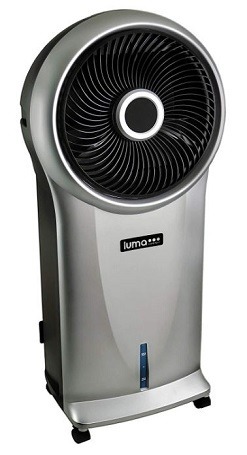
Evaporative portable coolers also rely on water to keep a room cool. But they don’t have to be hooked to a water supply like water-cooled air conditioners. Instead, you regularly fill up the reservoir with water and keep adding more as necessary.
An evaporative air cooler works via a simple principle that we witness around us all the time. If you stand next to a pool, lake or ocean you will experience a cool breeze. What happens is that as hot air passes over the water, it takes up some of the moisture and its temperature drops.
The water you add to an evaporative cooler is used to lower the temperature of hot air before it is released into the room.
Because no venting or complicated installation is necessary, portable evaporative water coolers provide some flexibility in terms of where you can set one up. But it is a good idea to place one near a window with the back of the unit facing the opening.
This ensures that the unit receives and circulates fresh air only. Furthermore, this type of portable air conditioner is recommended mostly for places with hot climates. The warmer the air the more efficient the unit will be.
Pros
- No major installation necessary.
- Lighter and more portable than most compact air coolers.
- No ventilation necessary.
Cons
- Needs to be filled with water regularly.
- Doesn’t work well in cooler climates.
5. Fans
Though they are not air conditioners, portable fans can still provide decent cooling for small and mid-size rooms. Compared to portable air conditioners, fans are cheap to run and do not require any major installation.
You can use portable fan on its own to cool a room or use it to complement a portable air conditioning system.
Pros
- Can provide directional cooling.
- Cheap to operate.
- Easy installation.
- Highly portable
Cons
- Not ideal for large rooms. Even in smaller spaces, they are not as good as portable coolers.
- The strong directional air movements can be noisy and a bother.
Portable Air Conditioners: Pros and Cons

If you are thinking about climate control for your home, you have most likely wondered whether portable air conditioners would meet your needs. After all, they have some compelling advantages over central cooling systems. They are cheaper, portable and utilize less energy.
To make the right decision, it is important to weight both the good and bad of portable coolers. You can then determine whether they would work for your home. Here are the main pros and cons.
Pros
1. They are cheaper
While central air conditioners cost thousands of dollars, portable ACs barely clear $500. The cheapest ones start at around $250-$300. The higher the BTUs the higher the price goes with 14,000 BTU coolers costing between $400 and $500.
Considering that there is no installation cost involved, portable coolers seem to be a better bargain.
2. They can be moved around
Portability is one of the biggest selling points of these coolers. It is true that most portable air conditioners are quite heavy – not lightweight in the sense that you can lift it on your own and move it to another room.
But in comparison to other air conditioning systems, portable coolers are light.
Most units weight between 40 and 80 pounds with a few coming in at over 100 pounds. Thankfully, they have wheels, which make it easier to move them around.
Portability comes in handy when you want to cool different rooms at different times. You can wheel it to the living room in the morning and back to the bedroom at night.
3. Minimal installation required
Portable air conditioners do not require any ductwork. So you don’t have to worry about tearing open your walls or messing with your ceiling. Not only is it tedious work to install a network of ducts and vents, it also costs extra money.
With portable air conditioners, installation is easy. For most units, you can even do it yourself. All you need is to set up the exhaust hose as instructed in the manual.
If you have a water-cooled system, you simply need to connect it to a water source. If you have an evaporative cooler or portable fan, there is virtually no installation required.
4. Less maintenance required
With minimal installation also comes minimal maintenance. In traditional central air conditioners, the ductwork requires regular maintenance to ensure proper functioning. With no ducts, portable coolers are easy to maintain
Most of the maintenance work recommended in the instruction manual can be done without spending extra money on a technician. That more money saved.
5. They use less energy
While they are becoming increasingly energy efficient, central air conditioners still use a lot of power to keep multiple rooms cool. A portable air conditioner only cools the room that is in use, helping save a lot of energy.
Many manufacturers nowadays are making efforts to create energy efficient portable coolers that perform better but with less energy expenditure.
Cons
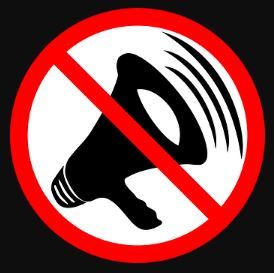
1. They are noisy
Unless you get a mini-split system where the ‘engine’ is outside, expect some noise from your portable air conditioner.
Most portable coolers come with all the components put together in one unit. As it cools the room, noise is inevitable as all these parts work together to keep the heat out.
When shopping for a portable cooler, look for those that produce as little noise as possible. The normal range is around 50 to 56dB. This is just below the normal level of conversation. But it can still be a bother when the house is quiet such as when you are sleeping.
Some of the quietest portable coolers can produce less than 40dB of noise, though they'll cost you more.
2. Pricier than window air conditioners
Window air conditioners are the choice climate control units for those who do not want a cumbersome portable cooler or the energy demands of a central cooling system. While window air conditioners and portable coolers are both used for cooling a single room, portable coolers are more expensive.
Window units can cost as low as $100 with the most expensive units (10,000 BTUs and above) costing less than $300. Portable coolers start at $250 and can cost as much as $500 for high-powered units.
On the upside, portable air conditioners cool better and more efficiently than small window units.
3. Not ideal for cooling multiple rooms
The biggest downside with portable air conditioners is that you can only cool one room at a time. If you want multiple rooms or your entire home climate-controlled, consider getting a mini-split system or invest in a central ail air conditioner.
The alternative is to buy a portable air conditioner for each room that needs cooling. But be careful, you might find yourself using more energy than if you had installed a central system.
The 10 Best Portable Air Conditioners for 2023
- 1Best Quiet Portable Air Conditioner: Honeywell MN12CES 12,000 BTU
- 2Best Small Portable Air Conditioner: NewAir Ultra-Compact 10,000 BTU
- 3Best 10,000 BTU Portable Air Conditioner: Global Air 10,000 BTU
- 4Best 12,000 BTU Portable Air Conditioner: DeLonghi America Whisper Cool
- 5Best 14,000 BTU Portable Air Conditioner: Whynter ARC-14SH
- 6Best 8000 BTU Portable Air Conditioner: SereneLife SLPAC8 8,000 BTU Portable Air Conditioner
- 7Best Budget Portable Air Conditioner: BLACK+DECKER BPACT08WT Portable AC
- 8Best Energy Saving (Up to 500 sq. ft.): LG LP1419IVSM Dual Inverter Technology Portable Air Conditioner
- 9Best Dual Hose Portable Air Conditioner: Whynter Elite ARC-122DS
- 10Best Portable Air Conditioner and Heater: Black + Decker BPACT12HWT
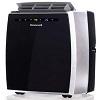
Honeywell MN12CES
- Best Quiet Portable Air Conditioner
Noise:
MediumDrainage:
Self-EvaporationSize:
SmallBTU:
12,000
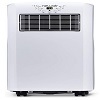
NewAir Ultra-Compact
- Best Small Portable Air Conditioner
Noise:
LowDrainage:
Self-EvaporationSize:
SmallBTU:
10,000
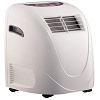
Global Air
- Best 10,000 BTU Portable Air Conditioner
Noise:
HighDrainage:
Self-EvaporationSize:
SmallBTU:
10,000
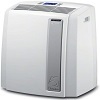
DeLonghi America Whisper Cool
- Best 12,000 BTU Portable Air Conditioner
Noise:
LowDrainage:
Self-EvaporationSize:
MediumBTU:
12,000

Whynter ARC-14SH
- Best 14,000 BTU Portable Air Conditioner
Noise:
HighDrainage:
Auto-EvaporationSize:
MediumBTU:
14,000
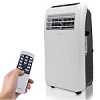
SereneLife SLPAC8
- Best 8,000 BTU Portable Air Conditioner
Noise:
MediumDrainage:
Self-EvaporationSize:
SmallBTU:
8,000

BLACK+DECKER BPACT08WT
- Best budget portable air conditioner
Noise:
MediumDrainage:
Self-EvaporationSize:
SmallBTU:
8,000

LG LP1419IVSM
- Best energy saving (up to 500 sq. ft.)
Noise:
LowDrainage:
Self-EvaporationSize:
MediumBTU:
14,000
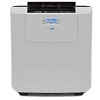
Whynter Elite ARC-122DS
- Best dual hose portable air conditioner
Noise:
MediumDrainage:
Self-EvaporationSize:
MediumBTU:
12,000
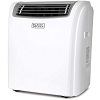
Black + Decker BPACT12HWT
- Best portable air conditioner and heater
Noise:
HighDrainage:
Self-EvaporationSize:
MediumBTU:
12,000
1. Best Quiet Portable Air Conditioner: Honeywell MN12CES 12,000 BTU
Noise level can be a big factor when deciding on a portable air conditioner.
While some units are quieter than others, they tend to trade off features to result in a quieter operation.
With a maximum decibel level of 55 dB, the 62 lb. Honeywell MN12CES offers plenty of features and cooling power, with a tolerable noise level at even the highest cooling settings, making it the best all-around unit with a noise level on the quiet side of the spectrum.
Pros
- Quiet operation.
- Auto-evaporation with the option of continuous drainage.
- Dual filtration.
- Built-in high capacity dehumidifier (69 pints/day).
- Wheels for easy portability.
Cons
- It’s heavy – this is a problem if you plan to carry it to an upstairs room.
Our Review
BTU
The Honeywell MN12CES has a cooling capacity of 12,000 BTU, with a cooling area up to 400 square feet. It includes three different fan speeds, along with a timer that you can set to shut off for when you aren’t nearby.
Ventilation
The Honeywell MN12CES is a single-hose mode that includes a window ventilation kit that takes just a few minutes to install from start to finish.
Drainage
With the Honeywell MN12CES, you never have to worry about tending the moisture build-up thanks to the auto-evaporation system.
Other Features
The Honeywell MN12CES comes with a remote control that allows convenient operation from anywhere in the room. If you do end up using the controls on the unit, you’ll appreciate the easy touch controls on the LCD display panel. This unit can also be used as a dehumidifier, ridding a space of up to 70 pints every 24 hours.
2. Best Small Portable Air Conditioner: NewAir Ultra-Compact 10,000 BTU
The whole point of a portable air conditioner is to be portable, so it makes sense that they should stay on the small side of things.
The smallest units also tend to blend a little better in a room, helping with the room’s overall aesthetic.
As far as small portable air conditioners go, you’ll be hard-pressed to find a better unit that combines both performance and size than the AC-10100E Ultra-Compact from NewAir, which measures 12.1 x 15.1 x 29.8 inches and weighs just over 60 lbs.
Pros
- The compact design makes it ideal for small spaces.
- Built-in dehumidifier.
- Self-evaporative.
- Option to set up continuous drainage when it’s very humid.
Cons
- Limited to small spaces.
Our Review
BTU
The AC-10100E has a BTU rating of 10,000 making it useful for a cooling area under 300 square feet, while taking up minimal space.
Ventilation
This unit uses a single hose system, and comes with a window installation kit that can accommodate windows up to 42 inches.
Drainage
The AC-10100E is self-evaporative, which means you rarely have to worry about emptying the unit’s moisture build-up. While it’s not quite auto-evaporative, it’s almost there.
Other Features
The AC-10100E comes with a 12-hour timer, sleep mode, a remote control, and an auto-fan function that automatically maintains your set temperature by raising and lowering the fan speed.
3. Best 10,000 BTU Portable Air Conditioner: Global Air 10,000 BTU
The Global Air 10,000 BTU unit is no-frills when it comes to features, but it is a very efficient unit that makes use of a sleek, pleasing design that easily blends into any room while providing smooth and quiet operation.
Pros
- Cools quickly and efficiently, despite its compact size.
- Remote control included.
- Self-evaporative.
- Affordable price.
Cons
- A bit loud.
Our Review
Ventilation
No surprise here, given its size: this Global Air uses single-hose ventilation, and includes a standard window kit.
The manufacturer-recommended max cooling area is 400 sq. ft., making the Global Air portable AC suitable for small and medium size rooms.
Drainage System
If you prefer not to empty your unit, you’ll appreciate the Global Air. It utilizes a self-evaporative system that also works to cool off the condenser by recycling any remaining condensation.
Other Features
The Global Air has a 2-Speed cooling fan along with a 4-way air direction help spread the air evenly throughout the space. A remote control lets you control the air conditioner from across the room, while digital controls give you an on-board option.
4. Best 12,000 BTU Portable Air Conditioner: DeLonghi America Whisper Cool
The DeLonghi America PACAN120EW 12,000 BTU Whisper Cool Portable Air Conditioner offers the best of both worlds when it comes to a mid-size unit, combining quiet operation with ample cooling power and some nice extra features.
Pros
- Efficiently cools large rooms.
- Quiet operation.
- Auto-evaporation.
- Remote control for easy control from your couch (or bed).
Cons
- Takes up a lot of floor space.
Our Review
Ventilation
This unit ventilates outside using a single hose that measures around 5 feet long, but can be extended to 8 feet if you need some extra room from the unit to the window.
With a cooling area of up to 450 square feet, the DeLonghi portable AC works great in small and medium size rooms.
Drainage
The DeLonghi America PACAN120EW evaporates condensation on its own by recirculating it within the system, so no annoying buckets or drain hoses here.
Other Features
There are plenty of added features worth mentioning.
The unit’s BioSilver air filter traps bacteria, dust and pollen, while also preventing the growth of mold and mildew.
The namesake Whisper Cool function cuts the noise down by about 50%, while the Real Feel mode controls the room’s humidity and temperature blend.
The unit’s remote operates the unit from across the room, and also stores easily in the top of it.
Durable casters make moving it around fairly effortless.
5. Best 14,000 BTU Portable Air Conditioner: Whynter ARC-14SH
Few full-size portable air conditioners actually deliver like the Whynter ARC-14SH, especially when you consider its low price.
Pros
- Plenty of power to cool larger spaces.
- Cools and heats for all-year-round comfort.
- Dual filters (pre-filter and activated carbon filter), maintain good indoor air quality.
- Dual hose design – allows it to cool large rooms faster and more efficiently.
- Built-in high-capacity dehumidifier (removes up to 101 pints/day).
Cons
- Pricey, which is expected for a portable AC, this powerful.
- The exhaust hose is not insulated. During cooling, it leaks heat, reducing cooling efficiency.
Our Review
4-in-1 Portable AC
With most portable air conditioners, the unit is only useful during the hot seasons. The Whynter ARC-14SH, in contrast, proves useful throughout the year thanks to its 4-in-1 functionality.
No, it doesn’t have a mode for every season. It has two primary modes: heating and cooling. It’s cooling range is 61°F - 89°F and it’s heating range is 61°F – 77°F.
So when it’s winter, you can still use the Whynter ARC-14SH for space heating.
The other two modes are standard functions found in most portable ACs. They are fan-only and dehumidifier.
The dehumidifier can remove up to 101 pints of moisture from the air in a day.
Ventilation
The Whynter ARC-14SH utilizes a dual-hose ventilation system, helping its efficiency while noticeably balancing out the room’s air pressure and feel. For a large room, that's important.
Drainage
The Whynter ARC-14SH completely recycles any remaining condensation that its auto-evaporative system misses, cooling its condenser and balancing out humidity.
Other Features
The controls are very simple and easy to use on this unit, and that includes its remote control. You can program temperatures, change fan speeds, and use preset timers with ease.
The Whynter ARC-14SH also includes a washable air filter that helps neutralize odor, and an also heat and dehumidify. It truly does it all, while still being easy to move from room to room.
6. Best 8000 BTU Portable Air Conditioner: SereneLife SLPAC8 8,000 BTU Portable Air Conditioner
An 8,000 BTU portable air conditioner is perfect for small rooms where a bigger AC would be wasteful.
The SereneLife portable AC cools and dehumidifies rooms up to 215 square feet.
Pros
- Perfect for small rooms.
- 3-in-1 functionality: cool, dry, and fan.
- Self-evaporative.
- Includes timer and sleep mode.
- Casters for easy mobility.
- Easy to use remote control.
Cons
- A bit noisy.
- The venting kit feels cheap and flimsy.
Our Review
3-in-1 Functionality
Like most portable air conditioners, SereneLife SLPAC8 doesn’t just cool the room. It also has a built-in dehumidifier that can extract up to 1.2 liters of moisture every hour.
Most users of the SereneLife portable AC won’t have to drain it. The self-evaporative feature carries the moisture out along with hot air.
The only time you’ll need to drain the pan is to live in a very humid area or experience several days of high humidity.
In addition to cooling and dehumidifying, you can also use the SereneLife AC as a fan to circulate the air around the room gently. This is handy when you only need mild cooling. Just turn on the fan-only mode and set your preferred fan speed.
Perfect for Compact Spaces
Using a high BTU portable AC in a small room is wasteful. You’ll also have to put up with a noisy fan right next to you.
The SereneLife portable AC is rated at 8,000 BTU, making it perfect for small rooms up to 215 square feet. It’s great for a small bedroom, nurseries, home offices, and small living rooms.
Complete Installation Kit
The SereneLife SLPAC8 portable air conditioner comes ready to install. Everything you need to set it up and vent it outside the window is included.
Several customers say the vent hose feels flimsy and poorly made. It works well, but you may need to replace it soon.
Remote Control
You can adjust temperature and other settings using the touch control panel on the AC or, more conveniently, using the included remote control.
On the remote control, you can adjust the temperature, adjust fan speed, set an auto-off timer, and switch to sleep, fan, or dehumidifier mode.
Other Features
Other notable features of the SereneLife SLPAC8 include a washable filter screen that keeps out allergens and smooth-rolling casters for easy portability.7. Best Budget Portable Air Conditioner: BLACK+DECKER BPACT08WT Portable AC
If you are shopping on a budget but still want to get a high-quality portable AC with powerful cooling performance, we recommend the BLACK+DECKER BPACT08WT portable air conditioner.
It provides fast, efficient, and relatively quiet cooling for small rooms up to 200 square feet.Pros
- Affordable price.
- Great for small spaces.
- Self-evaporative – reduces maintenance.
- 3-in-1 functionality.
- Includes timer and sleep mode.
Cons
- A bit loud.
Our Review
Cooler, Dehumidifier and Fan
The BLACK+DECKER BPACT08WT has the usual 3-in-1 design. You can use it to cool down a room, select the dehumidifier setting to reduce moisture levels in the air, or as a basic fan.
It’s easy to switch between the different functions using the remote control or control panel.
Great for Small Rooms
The cooling power of the BLACK+DECKER BPACT08WT is 8,000 BTUs and is recommended for spaces smaller than 200 square feet.
You can use it in your small bedroom, a baby nursery, or home office.
Note, however, that the AC is fairly noisy, especially when you turn the fan to the highest speed. It’s smooth fan noise, nothing jarring. Most buyers have gotten used to it, and some even find it soothing.
But if you prefer a quiet sleeping environment, consider the Honeywell MN12CES (our quietest pick) or take a look at our reviews of the top 5 quietest portable air conditioners.
Self-evaporative
You likely will never need to empty the BLACK+DECKER BPACT08WT portable AC. It is self-evaporative, meaning that all the moisture it collects is exhausted outside along with hot air.
Unless you live in a humid area and use the dehumidifier mode for a long period, the AC manages to get rid of all the collected moisture. If the pan does fill up, use the included drain tube to empty it.
Remote Control
The handy remote control lets you control temperature and other settings without having to stand up. You can switch to sleep, dry, or fan mode set a timer to automatically turn the AC off, or adjust the fan speed.
Filter
Air going through the AC is filtered to get rid of allergens and other pollutants. While the BLACK+DECKER portable AC is not a replacement for a proper air purifier, it can improve indoor air quality.
The filter is washable, so you won’t need to get replacements any time soon.8. Best Energy Saving (Up to 500 sq. ft.): LG LP1419IVSM Dual Inverter Technology Portable Air Conditioner
According to LG, their LP1419IVSM portable air conditioner saves you up 40% in energy than ordinary portable ACs.
The big savings are thanks to the dual inverter technology used in the AC. This technology, combined with a special motor design, also greatly reduces noise levels, making the LG LP1419IVSM one of the quietest portable air conditioner.Pros
- Huge energy savings.
- Operates quietly.
- WiFi connectivity – remote app control and smart assistant compatible.
- Ideal for large spaces.
Cons
- Pricey.
- The app is nice but slow.
Our Review
Dual Inverter Compressor
The LG LP1419IVSM contains a lot more tech than most portable air conditioners. Let’s start with the most important one, the dual inverter compressor.
Ordinary compressors turn on when cooling is needed and off when the room has reached the set temperature. They have two modes only – on and off.
An inverter compressor, in contrast, drives the motor at variable speeds to match cooling demand. This means the motor is not always running at maximum speed, which saves energy.
A dual inverter compressor is an advanced version of an inverter compressor. It has more precise cooling and higher energy savings.
Quiet Operation
A dual inverter compressor has another big advantage – it’s much quieter and has almost no vibrations than the single inverter and non-inverter compressor ACs.
Combined with the brushless DC motor, the LG LP1419IVSM runs surprisingly quietly for a portable AC of its size and power.
At the highest fan speed, the noise level is about 52dB, which is quieter than most portable ACs at the lowest fan speed.
Switch to the lowest fan speed, and noise level drops to a whisper quiet 44dB, perfect for bedside or keeping sleeping baby cool.
Powerful Cooling and Dehumidification
Rated at 14,000 BTUs of cooling power, the LG LP1419IVSM quickly brings down temperatures in spaces up to 500 square feet.
If you need to cool a large open living room, bedroom, or any other space, the LG LP1419IVSM is a great choice.
You can also use the LG LP1419IVSM to dehumidify the room. The AC is auto-evaporative, so you don’t need to drain it unless the humidity levels are unusually high.
Remote Control
The LCD display remote control allows you to change temperature, adjust fan speed, switch to sleep mode or set a timer from your couch's comfort.
If you want, you can also use the control panel at the top of the AC.
WiFi Connectivity
The control panel and remote control are not the only way to control the LG LP1419IVSM portable AC. This LG air conditioner has WiFi-enabled smart capabilities. This gives you two additional control options.
One, you can control the AC from the SmartThinQ app. This includes setting the temperature, changing modes, and switching the AC on and off from anywhere.
The best thing about the app is that it works. Considering all the smart air conditioners we’ve reviewed with horrible, clunky apps, this is a big deal.
We’ve not seen any complaints of a dropped connection or the app crashing. The only complaint from users is that it loads a tad slowly. Small price, though.
You can also control the LG LP1419IVSM by voice through Google Assistant or Amazon Alexa. You can use your smartphone or a smart speaker to send voice commands. And if you have a smart home, it should be easy to integrate the LG LP1419IVSM.
Unfortunately, the LG LP1419IVSM is not compatible with Siri or HomeKit. If you are in the Apple ecosystem, find another smart AC or see if you can get a workaround to have the LG LP1419IVSM work with your smart home.9. Best Dual Hose Portable Air Conditioner: Whynter Elite ARC-122DS
A dual hose portable AC cools a room faster and more efficiently compared to a single hose AC. One of the best dual hose portable ACs is the Whynter Elite ARC-122DS 12,000 BTU portable air conditioner.
Pros
- Dual hose design cools fast and efficiently.
- Not too noisy - most people say they can sleep comfortably with the unit turned on.
- Auto drainage.
- Remote control.
- Programmable auto on and off timer.
Cons
- Costs more than similar BTU single hose ACs.
- Difficult to carry up and down the stairs.
Our Review
Dual Hose
You probably won’t realize it if this is your first portable AC, but it is miles better than standard single hose portable air conditioners.
Customers who were upgrading from a single hose AC say they experience much faster cooling.
The dual hose design of the Whynter Elite ARC-122DS is especially handy in extra hot weather when you need to cool down a room quickly. It’s also great for cooling larger rooms.
The best part is that setting up a dual hose AC is not much more difficult than setting up a single hose unit. A dual hose unit will still fit in a standard window.
12,000 BTU With Three Modes
The Whynter Elite ARC-122DS is rated at 12,000 BTUs, making it suitable for rooms up to 400 square feet.
The AC operates in three modes: a standard cooling mode, a dehumidification mode and a fan-only mode.
In cooling mode, you can select your preferred temperature on the screen or remote control and the unit will maintain it.
Powerful Dehumidification
If you live in a very humid area, the Whynter Elite ARC-122DS is a great choice. It’s dual hose design allows it to take plenty of water out of the air - up to 76 pints per day.
While most people don't need to drain the AC (all water is exhausted outside), you’ll have to manually drain it if you live in a humid area. Set up a line to carry water away from the AC.
Programmable On/Off Timer
Using buttons on the AC or the remote control, you can set the Whynter Elite ARC-122DS AC to automatically turn on or off after a number of hours.
This improves energy savings, since the AC only runs when you need it to. Secondly, it improves comfort. You can set the AC to start cooling the living room before you get home or have it turn off a couple hours after you sleep so it doesn't get too cold.
10. Best Portable Air Conditioner and Heater: Black + Decker BPACT12HWT
If you are looking for a portable air conditioner you can use all year round, we recommend the 4-in-1 Black + Decker BPACT12HWT air conditioner and heater.
It’s perfect for cooling, heating and dehumidifying small rooms.
Pros
- 4 modes: cool, heat, fan and dehumidify.
- Remote control.
- Includes an energy-saving auto mode.
- Auto drainage.
- Includes timer and swing functions.
Cons
- Noisy.
- Heavy - difficult to carry up and down the stairs.
- Not suitable for large rooms.
Our Review
4-in-1 Portable AC
The Black + Decker BPACT12HWT has the usual three modes found in most portable air conditioners: cool, dry and fan.
In addition, it comes with a heating function that’s perfect for colder weather. You can select a temperature up to 81°F.
12,000 BTU - Ideal for Small Rooms
When in cooling mode, the Black + Decker BPACT12HWT is suitable for rooms up to 300 square feet. In heating mode, it covers a space for 250 square feet.
If you are looking for a portable AC and heater for your large bedroom or open living room, this is not it. It’s more suited to small home offices, bedrooms, cabins, baby nursery and other small spaces.
Multiple Modes and Settings
The control panel and the remote control both provide a wide range of settings to help you tune the room to your comfort.
You can select among four modes: cool, heat, dry and fan.
In cool, heat and fan modes, you can select between three fan speeds. Higher fan speed increases cooling or heating, while reducing fan speed makes the AC quieter.
In cool and heat mode, the Black + Decker BPACT12HWT has an energy-saving auto setting. The AC will automatically adjust fan speed to maintain the selected room temperature.
Another energy-saving feature is the auto off/on timer.
Other settings accessible from the remote control include SLEEP (regulates temperature to keep you comfortable through the night), MAX for cooling down the room rapidly and SWING to turn on oscillation for better air distribution.
Complete Kit
The Black + Decker BPACT12HWT portable AC comes with a complete window ventilation kit. The kit includes a drain hose to empty water collected from the air. But you most likely won’t need it as the AC is self-evaporative.
Portable Air Conditioner Buying Guide
Portable air conditioners differ by maximum cooling area, energy efficiency, venting configuration, brand, and special features like remote control operation, multiple operating modes, specialized air filters, programmable timers, etc. This can make it quite difficult to select a just right unit for you.
The following buying guide is designed to provide you with an outline to help you find the best portable air conditioner:
Versatility
The best portable air conditioners are designed with features that make them convenient and versatile. In addition to cooling, they are equipped with multiple functions. A fan function helps to circulate air in the room.
In contrast, some portable air conditioners feature a heating capability, making it easier to maintain a comfortable temperature all year round.
Filter
Portable air conditioners are typically equipped with a filter that helps remove contaminants from the air they are cooling. These include:
Efficiency
Portable air conditioners are typically energy-efficient and help you save money on your monthly electric bill.
The EER or the Energy Efficiency Ratio helps to measure the efficiency of a portable air conditioner - the higher the EER of a unit, the more efficient it will be. Typically, a rating of 10 is considered excellent for portable air conditioners.
Special features
There are some other features that you should look out for as they increase the convenience of a unit.
For instance, a programmable timer makes it possible for you to turn the unit on and off at specific times. This helps reduce energy consumption as the air conditioner is operated only when needed.
Some of the best portable air conditioners are remote-controlled. Having a remote control allows you to adjust the settings and turn the unit on and off without needing to get up from the couch or the bed.
If you find the light from the LED display uncomfortable at night, the lamp-off feature allows you to turn off the panel display while you sleep.
What to Look for When Purchasing a Portable Air Conditioner
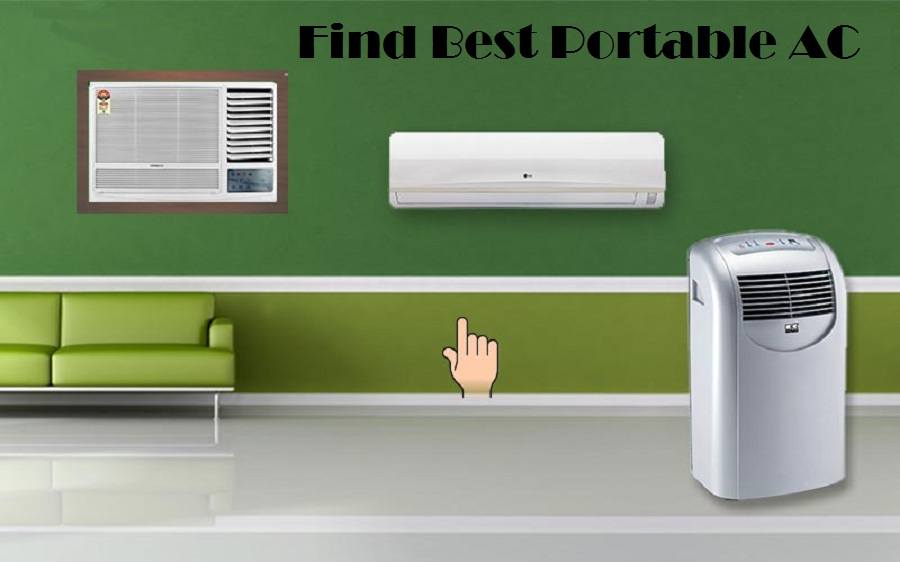
Although it may seem like a simple device, portable air conditioners have numerous factors and characteristics that differentiate themselves from others.
You have plenty of options when it comes to purchasing a unit for your own needs, but there are certain factors that matter the most. Knowing what they are beforehand will help you find the portable air conditioner that is perfect for your space’s size, and your own personal preferences.
You can certainly classify portable air conditioners in many different ways, but these are the factors that should be most important to you when shopping.
BTU
Your main criteria for portable air conditioners begins here. BTU, or British Thermal Unit, is a way of measuring a portable air conditioner’s output, which in turn decides the size of room it is appropriate for.
Without getting too deep into it, BTU represents the amount of energy needed to raise the temperature of 1 pound of water 1°F.
This works in reverse when it comes to a portable air conditioner. In this case, it refers to how many BTU’s per hour the unit can remove from the air around it inside a space.
Unit’s with a higher BTU amount are intended for use in larger rooms. Lower amounts are for smaller rooms. Use a high BTU unit in a small room, and you’ll end up with an overworked unit that isn’t able to remove as much moisture, leaving you with a clammy, humid space.
Use a unit with lower BTU’s in a large space, and you’ll get a room that’s not nearly cool enough, along with an overworked unit that never shuts off.
There is a way to calculate your BTU needs, however.
An air conditioner needs approximately 20 BTU for each square foot of the space you are going to be using it in most often. Measuring the square footage can be done by multiplying the length of the room by the width.
Here estimates for three different room sizes:
Additional room characteristics such as ceiling size, sunlight amount, and any appliances giving of extra heat should be considered as well. You may need to slightly increase the BTU amount depending on these variables, often by 10%
Ventilation
Portable air conditioner units need to vent out the hot air as a part of the actual air cooling process.
The hot air needs to be directed to the outside of the room, or else you are cooling and heating the air in the room at the same time, and that’s not exactly productive.
The ventilation is done through a hose, which can be sent outside of a window, through a wall, or outside of a sliding door if possible.
Portable air conditioners come with kits that allow you to close off the gap in windows and doors if you are ventilating outside.
Selecting The Correct Size (BTU Capacity)
Single vs. Double Hose
As far as hoses go, you have two options: single-hose, and double-hose.
A single-hose portable air conditioner draws air from inside the room, cools it, and then returns the majority of the air back into the room. Some of this air is used to cool the unit, and the rest is blown through the air conditioner's one exhaust hose.
Dual-hose systems pull in the room air, cool it down, and then release it back into the area. The unit gets hot during the process, so one of the intake hose pulls in air from outside to cool down the unit. The air is then let out through the second hose.
A double-hose unit is more energy efficient, and avoids creating negative air pressure in a space. They can sometimes be more expensive as well.
Noise
You may not realize it initially, but the noise level of a portable air conditioner is definitely worth considering.
You may not mind having a unit that is slightly more noisy inside your own room or office. On the other hand, having one in another part of your home where you may be doing things such as watching television or entertaining guests could be a big hindrance if it’s loud.
Most portable air conditioners have a decibel rating that gives you the decibel level when the unit is on its max setting. Be mindful of where you will be using the unit, and if a little noise is going to cause issues.
Drainage
Portable air conditioners remove water from the air when cooling. The unavoidable result is condensation and water buildup inside of the unit, which needs to be addressed.
Self-evaporative units exhaust all of the condensate that is built up, resulting in you being able to run the unit without worrying about it overflowing.
Partially self-evaporative units can evaporate most of the moisture into their own hot air exhaust, resulting in little to no water to empty on your own.
Most units at least have a drain hose that you can extend towards a floor drain. If you want to direct the water up and away, you’ll need to acquire what’s known as a condensate pump. These are handy if you lack a floor drain or have a drainage area above the unit’s level.
The simplest and most affordable portable air conditioner models generally have an internal container that collects the extra water. These need to be emptied on a regular basis during use.
Extra Features
Many portable air conditioners come with some helpful added features that make them both easier to use and more convenient as well.
One of the more common features most units have is the ability to adjust fan speed and temperature level.
Remote controls are a common feature as well.
If the unit is going to be put in a strategic electrical outlet spot, consider a model that has a built-in power strip so you can keep nearby other appliances and lighting fed with power.
Other units provide more climate control versatility, allowing themselves to operate as dehumidifiers (drying the air but not cooling it), and/or operate as a heater. Some have the capabilities of all three. This can help you avoid buying three separate appliances.

Every room is unique, and cooling energy requirements will vary by climate, etc.
For these and other practical reasons, you can't always accurately calculate the exact number of BTUs (British Thermal Units) you'll need for a given room.
But you can get close enough to ensure you end up with the right sized unit.
Manufacturers of portable air conditioners understand that buyers cannot calculate BTU requirements accurately, so they design their systems to cover a wide range of requirements and room sizes.
When picking a portable air conditioner for a room, the rule of thumb is that it will need need about 20 BTU for each square foot of floorspace you are cooling.
To calculate your square footage, multiply the longest length of the room by the longest width.
If you have a complex or irregularly shaped room, you’ll need to first divide the room into several rectangular sections and then calculate the footage of each separately.
Alternatively, you can ask your real estate agent or developer to help you calculate the room size. They’ll most likely even have the exact room size written down somewhere in official documents.
Here’s a quick ballpark estimate of a good BTU range to cool three common room sizes:
Note: Most portable air conditioners display two BTU ratings. One, the older ASHRAE rating and the second one a lower Department of Energy rating. This does not indicate two cooling capacities - the unit has the same cooling performance.
The two ratings are as a result of newer DOE efficiency standards for portable air conditioners.
Adjusting BTU Rating For Special Conditions
There are a few other factor that you need to consider, too. Each will impact the BTU rating in some way, as follows:
Basically, any space that has anything that causes it to be warmer than a standard room, or increases its volume of air that needs to be cooled will need more BTU’s on top of the standard calculation.
By following these guidelines, you can be sure you’ll choose the right-sized portable air conditioner for your room.
Other Factors to Consider
Ventilation
All portable air conditioners need to vent hot air out of the room being cooled, as a part of the cooling process.
The hot air needs to be directed out of the room, or you’ll simply be pumping hot exhaust right back into the room and defeating the purpose of the unit.
Types of Ventilation Systems
Portable air conditioners have two different ventilation options: single-hose, or double-hose.
A single-hose portable air conditioning unit draws warm air from your room and cools it down before returning the majority of the air, now cooled, back into the room.
Part of the intake air is siphoned-off and used to pull heat off of the air conditioner's evaporator; that air is warmed considerably as it does its job, so it is vented outside using the air conditioner's single exhaust hose.
A dual-hose portable air conditioner pulls in room air, cools it down, and release all of it back into your room. The unit uses 100% outside air to transport heat away from the evaporator unit.
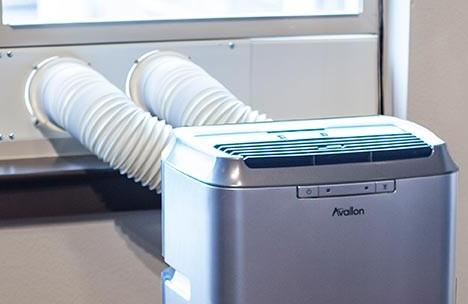
One hose pulls in air from outside to cool down the unit, and the hot exhaust air is vented back outside through the second hose.
A dual-hose portable unit does not create the negative pressure in a room like single hose models do, and a dual-hose unit is often more efficient than a single-hose portable unit. It can also cool a larger space faster.
The drawback to a dual-hose portable air conditioner is that some models use two internal fans, which can lead to a slightly higher energy usage.
Ventilation Location
Choosing a unit that can work with the preferred ventilation opening in your room is a key consideration when buying a portable air conditioner.
Most units are designed to vent air outside through a window, a door or a wall. Sometimes, you will need to do a little installation work.
Windows
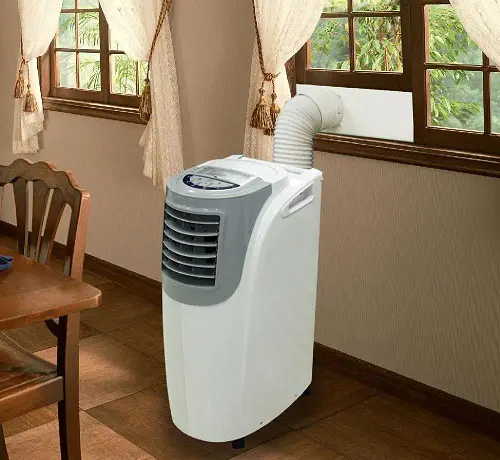
Most portable air conditioners come with a window kit to direct your ventilation outside. The kit includes either one or two vent hoses, a bracket, and some hose adapters.
Installation is typically very easy, and really just involves opening the window enough to fit the bracket in, and then closing the window back down on it to seal the room off. The hose goes from the unit to the bracket, and directs airflow outside.
This makes moving the unit to another location easy, as long as you have a window within the reach of the vent hose.
Doors
It’s also possible to set up a ventilation bracket with a sliding glass door if you need the unit in a larger room.
The idea is the same as a window install, but you may need a special kit, or an extra piece of bracketing to fit the space.
Walls
Some may prefer to direct the hot air through a wall to outside or to another room or part of the house, such as a garage or storage room.
Venting through a wall takes a little more ingenuity and planning, but can often be done with a jigsaw and some well-placed measurements. Look at our gallery below for the general idea.
No matter which ventilation method you choose, just be sure that you can ventilate your unit appropriately. Portable air conditioners cannot do their job without it.
Features and Options

The best portable air conditioners are available in a number of different types and offer a range of options that give you more control and versatility over the unit’s operation.
Programmability
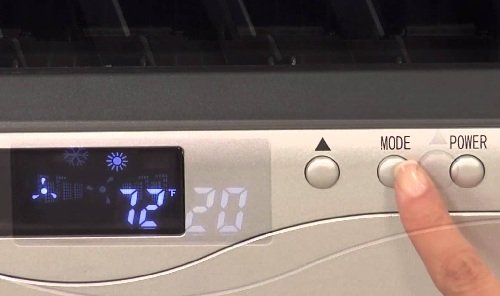
Most people like to have a unit that does more than just power on and off.
Units that have programmable features let you to set specific temperatures, air speeds, and duration of operation. This can be especially helpful when you are trying to control the noise level of a unit, or have the air conditioner operate and maintain a specific temperature for a set time.
Electrical Strips
Some units have a built-in electrical strip that allows you to plug in other cords and devices. That can come in pretty handy.
Heat Pumps

If you want to heat a room in the winter and cool it in the summer, then look for units that have a heat pump, which can push heat in either direction.
If you’re in an in-between season like spring or fall, and need to alternate from heating to cooling depending on time of day, a unit with a heat pump can be especially convenient.
Dehumidifier
Many portable air conditioners can double as a dehumidifier, giving you a two-in-one appliance that can save you money and maintenance, especially when using one in an area such as a basement.
While all portable air conditioners act as a dehumidifier to some extent, some have exclusive settings that allow them to operate solely as a dehumidifier.
Noise Level

The vast majority of portable air conditioners are not completely silent.
Depending on the main location of your unit, the decibel noise level and even the quality of the sound emitted can be very significant when deciding on the best portable air conditioner for your room.
If you plan on using the unit in a living room or dining room area, the noise level should be as low as possible,
In the bedroom, decibel level may not be as important as the type of noise emitted.
Some people prefer to have what’s known as “white noise” when they are sleeping, which is exactly what many portable air conditioners generate.
If you don’t mind a little bit of humming noise, then anything in the 50-56dB range is good enough.
If you want something ultra-quite, look for something in the low 40s. You might even come across some with below 40dB noise rating, though they tend to be pricey.
Drainage Options
Because they often cool warm, humid air, portable air conditioners need some way to remove water from the air and to move it out of the unit. Every unit will have water condensation inside that needs to be dealt with.
There are four main methods used to handle condensation; each has its own pros and cons.
1. Fully Self-Evaporative
A self evaporating portable air conditioner exhausts all of the condensate that is built up by sending it out with the hot exhaust air. This means you’ll never have to deal with dumping or draining water.
If you want to constantly leave your unit unattended, this is your best option. That said, some fully evaporative portable air conditioner are not suitable for extremely high humidity environments - make sure you check the relative humidity range on a unit, before you buy.
2. Partially Self-Evaporative

Partially evaporative units can evaporate most of the moisture into their own hot air exhaust, resulting in little to no water to empty on your own. The amount of drainage or tray dumping required depends on the usage time and environmental conditions of the area being cooled.
3. Gravity Drain/Drain Hose
Most portable air conditioners have the option of a permanent water drain hose connection to ensure that any water condensation is drained outside. Most drain tubes direct the water to a nearby floor drain.
4. Condensate Pumps
Condensate pumps are a separate accessory. They help to pump the collected water through the drain hose. This means that the hose can be routed upwards and through a window, for example, if you need to cool a basement.
Buckets
The simplest portable air conditioner models have an internal container that collects the extra water. These trays or buckets need to be dumped out on a regular basis during its use.
Reliability
This is extremely important. There is nothing as disappointing as spending hundreds of dollars on something that fails you when you need it most.
Before you buy a portable air conditioner, make sure it will not let you down. Of course, there is no way to be a hundred percent sure that it will work as expected. But customer reviews should give you an idea of how reliable a unit is.
If too many people complain of frequent breakdowns or poor performance, click away to another brand.
Another good sign of reliability is a strong and long warranty. It indicates the manufacturer’s confidence in their product. The standard warranty period provided by most manufacturers is one year.
Ease of Use
Here is something many people don’t take into account when buying portable air conditioners: how easy it will be to install and operate.
It is common to come across customers complaining about complicated setup processes, unclear manufacturer instructions and all-round frustration with a unit.
Most portable coolers should be simple enough that you can easily install them on your own without any special tools or skills. And even after installation, a unit should be easy to operate. If you have to keep going back to the manual to figure out how to change a certain setting, that’s not a good sign.
Some of the best portable coolers come with a remote control that makes it easier to change settings and program the unit.
Water-Cooled vs. Dehumidifying (Air-Cooled)
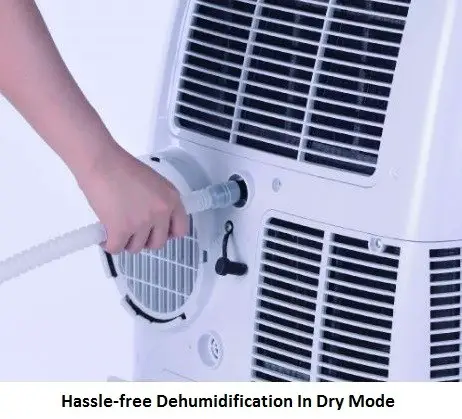
There are generally two types of portable air conditioners: water-cooled coolers and air-cooled dehumidifying coolers. The best choice for you will depend mostly on your climate.
Water-cooled portable air conditioners are at their most efficient in hot climates. They’ll effectively bring down temperature in the room.
Air-cooled conditioners on the other hand, are ideal for humid climates. This is because they can provide both cooling and dehumidifying functions.
If you live in a place that experiences dry summers, get the first type. If your area frequently experiences heat accompanied by high humidity (e.g. areas near the ocean), the second type is better for you.
Don't Forget to Read the Reviews!

As you go through our top portable air conditioner picks, click the provided links to read our in-depth review of best portable air conditioners. Then, click over to Amazon and other retailers to read their customers' reviews, too.
Our expert reviews will help you narrow down your options and eventually find the best portable cooler for your budget and needs.
If want to do a bit more homework on a specific portable cooler, you can look at what other customers are saying on the Amazon product page. You will also find links in our reviews to quickly get you there.
Focus mostly on verified customer reviews. These are the most reliable. Then, take a look at the 1-star reviews, to get a feel for the worst issues of each model.
Check what different customers are saying about reliability, ease of use, customer support and overall experience. This will give you an idea of what to expect if you settle for that specific air conditioner.
How We Rate Portable Air Conditioners

Our 5-star rating system considers the following features and specifications.
Customer Reviews
We give a lot of priority to third party verified owner reviews of each model. For a model to make our short list, they need to have a 3.5 star rating or higher on at least one major consumer review or retail site. We give priority to products that have over a dozen ratings across multiple sites.
Price for BTU
This is obviously the most important factor when assessing a unit. Higher BTU ratings almost always come with a higher price, and often a few more features. We prefer units that deliver the highest BTU-per-dollar.
Noise
A portable air conditioner can be the coolest, most feature-rich unit on the market, but if it’s loud, it’s going to go down on our overall rating. The best units operate at a tolerable level (~77db or lower) on a maximum setting, and a very quiet level (~55-60 db) when they are on low and medium fan settings.
The fans aren’t the only thing that adds to the noise level. Compressors play a big role as well.
Weight
The lower the weight, the more portable the unit is. Nobody wants to deal with an unnecessarily heavy air conditioner, even if it has all the extra features you appreciate. Moving it around your property should be fairly easy, which requires a lower weight.
Price
We are firm believers in getting what you pay for. If we don’t think a unit’s price reflects its actual value, then it won't make our short list.
Ventilation
We prefer dual-hose models over single-hose, due to the more efficient operation and lack of back pressure issues. That said, most portable ACs are single-hose.
Drainage
All things being equal, we prefer units that have an auto-drain function that removes all humidity from the room without requiring drainage tubes, buckets or trays. That said, achieving 100% auto-evaporative exhaust often comes at the expense of a higher noise level and less energy efficiency.
Also, keep in mind that even a portable AC with an auto-drain function may need to be manually drained if there's too much humidity in the area. That's why most portable ACs include a manual drain port as well as a drain hose.
Features
Some extra features barely improve the unit, while others have a huge role in its overall functionality, ease of use, and operation. Features such as a remote control, different fan speeds, and additional capabilities such as heating and dehumidifying can really help to push a unit over the top.
How to Install a Portable Air Conditioner
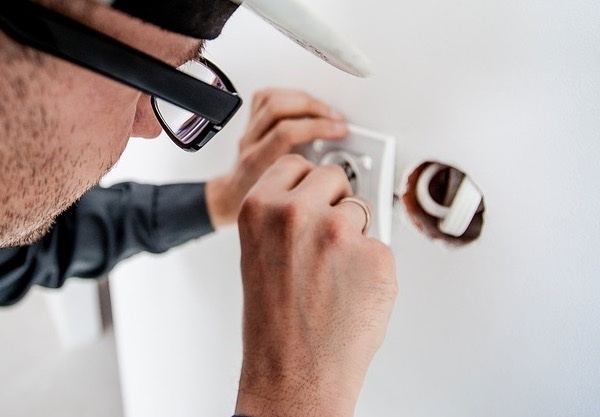
Generally, portable air conditioners do not require intensive installation. In fact, most can be installed without the help of a professional.
The installation process varies from one type and brand to another. So the best place to seek guidance is the instruction manual accompanying the portable cooler and if that fails, contact customer support.
If you are buying the traditional window-vented portable cooler, then it should come with a venting kit that can be used with a window, door or wall. Window and door kits are the easiest to install.
For wall ventilation, a bit more work is required since you have to drill the right-sized hole through the wall.
Here is a brief video on installing a window-vented portable air conditioner.
If you need to ventilate the unit through a wall, here’s a short instructional video.
If you are planning to buy a water-cooled portable air conditioner, no venting is necessary. But you have to set up a water source and drain. Use the manufacturer’s manual to properly install and set up the cooler.
However you choose to install the AC, remember to leave adequate clearance around it for proper air circulation.
Want to learn more? Read our in-depth installation guide for portable air conditioners.
Maintenance Tips for Portable Air Conditioners
Because of their size and simple setup, portable air conditioners are easy to maintain. To keep your portable cooler working well, you need to pay attention to various components such as the air filter and water drainage.
Here are the most important maintenance tips to keep in mind and implement.
Regularly clean and replace the air filters
As cool air passes through the portable cooler and into the room, it is filtered to ensure it is free of dust and other allergenic particles. With time, the filters fill up with trapped particles.
Without regular cleaning, some of the dust clogging the filters might start getting into the room along with the cool air. It also increases energy usage as the unit has to work harder to get air through the clogged filters.
The frequency of cleaning depends on how often you use your unit. If you use it daily, clean the filters weekly. If you use it less often, you can clean it every couple of weeks or every month.
Refer to the manual for instructions on how to remove the filter and clean it. The manual should also guide you on how often you should replace the filters.
Keep the hose straight and short
Due to natural condensation, moisture could form inside the hose and trickle back into the portable cooler. This could damage the internal electronics.
When installing, make sure the unit is close enough to a window such that the hose does not have to extend over a long distance.
Additionally, check the inside of the hose every now and then to ensure there is no excess moisture build-up.
Regular cleaning
Keep the body clean by wiping it regularly with a soft damp cloth. Avoid harsh detergents as they could damage the unit.
Occasionally, use a vacuum to clear the air intake vents.
At the beginning and at the end of the season, give the unit a deep clean. This involves opening it up and cleaning individual components including the filters, vents, cooling coils and external housing. Remember to unplug it before you take it apart.
Proper Storage
At the end of the season, it is important that you properly store the cooler in such a way that it will still be good for use when the hot season rolls around again. The exception is if your unit has a heat pump, meaning you can continue using it to heat the room during the cold season.
Drain all the water and give the unit a deep clean before stowing it away. Put the unit in fan mode for around two hours to completely dry out the interior.
If you have the original box it was delivered in, put it back in and store it in a cool and dry area. If you don’t have a big enough box, cover it with a plastic sheet.
Avoid storing the unit in the garage or attic. The big temperature fluctuations in these areas are not ideal. A storage closet somewhere in the house will do.
Before you start using it again next season, remember to clean it first before switching it on.
Portable Air Conditioners: FAQs

Portable ACs vs. Window AC: Which one is better for cooling?
Just looking at performance, a window unit is better. It operates more efficiently, allowing it to cool a larger area using less power.
But if you need an AC that you can move around from room to room, a portable AC is better. A portable AC is also the best option for apartments with regulations banning the installation of window units.
Do all portable AC units need to be vented outside a window?
Evaporative coolers, also called swamp coolers, don’t need to be ventilated. But these are not real air conditioners since you can’t even set a specific temperature.
So, strictly speaking, all portable AC units need to be vented. Venting takes hot air outside. Without it, the unit would keep working without any drop in room temperature since all the hot air is being exhausted back into the room.
Do you have to empty water from a portable air conditioner?
It depends on the type of AC and the level of humidity.
Most portable ACs are self-evaporative. Moisture collected from the air is evaporated out of the room through the window vent alongside hot air.
In most cases, you don’t need to drain water from the portable AC. However, if you plan to run the dehumidifier continuously or if the level of humidity is high, there may be too much water for the AC to evaporate fully.
Most units have a small internal tank to store water in such cases. You’ll need to empty the water when it fills the tank. Alternatively, connect a drain hose to the AC to drain the water continuously.
Can you use a portable AC in a room with no windows?
Yes, as long as you can find a suitable opening to vent the unit. A sliding door is the next best option though you may need to buy a venting kit specifically designed for sliding doors.
You can also vent the unit through the wall, though that will require hiring a pro.
You can also vent the AC through a drop ceiling.
If none of these alternatives will work for you, consider getting a swamp cooler (evaporative cooler). It’s not as good as a compressor air conditioner, but it can significantly cool a small room.
Do portable air conditioners work well?
A good portable air conditioner will cool the room quickly and last long. However, for the best cooling performance and durability, a window AC, through the wall, AC, or mini-split, are better choices.
A portable AC’s biggest advantage is convenience. It’s easy to move around from room to room and don’t require permanent installation or mounting.
Is it worth buying a portable air conditioner?
It depends a lot on your particular situation. If you can install a window AC, it’s better value for your money because it’s more energy efficient. Same with a mini-split or a through-the-wall AC.
But if portability is important for you (that is, you want to be able to cool different rooms), then a portable air conditioner is worth it.
Look for an energy-efficient unit that doesn’t use a lot of power, and don’t forget to get the right size (BTUs) for the rooms you plan to cool.

